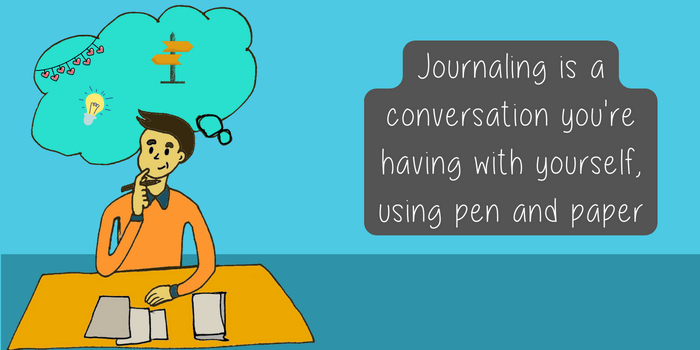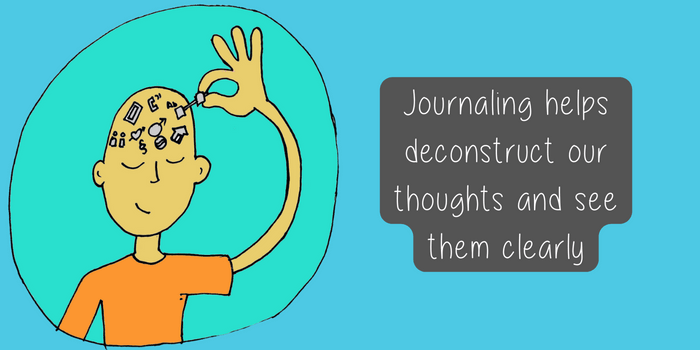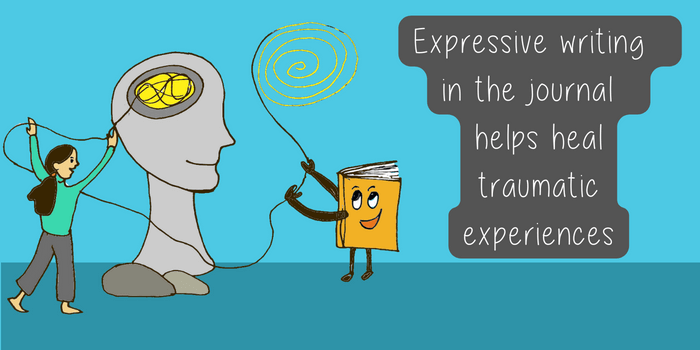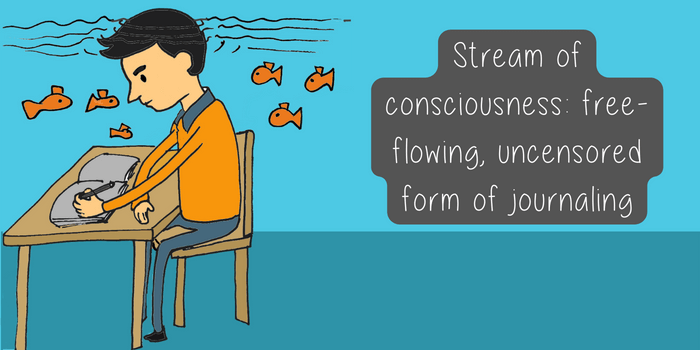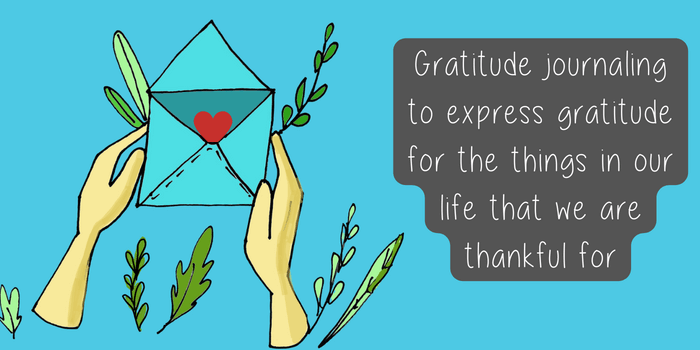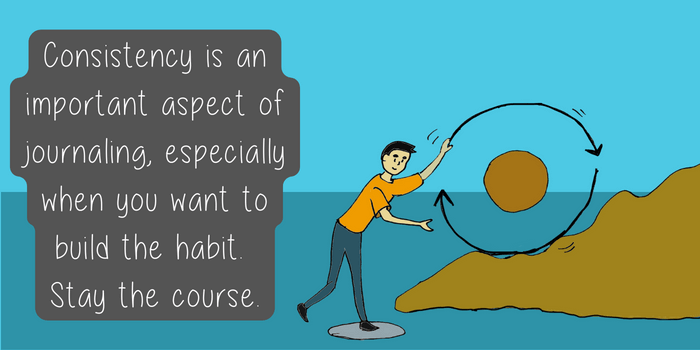Whenever I feel overwhelmed with thoughts and worries, I pull out a journal and just write for 10-15 min. Almost always, it calms me down and gives me clarity.
From my personal experience – nothing gives clarity like journaling. And all it takes is a few minutes.
So, what is journaling, really? Journaling is just the practice of letting your thoughts flow by writing in a notebook or on a digital medium. It is one of the most intimate journeys you will ever embark upon.
Also, do note that journaling is quite different from making to-do lists, which have more of a functional outcome, such as organizing daily tasks. Journaling, on the other hand, can be a form of catharsis. Think of journaling as a conversation you are having with yourself, using pen and paper.
Journaling can help you heal from past hurts and help handle strong emotions by giving a written form to your thoughts and feelings.
For beginners, journaling can be a bit confusing. What are you supposed to write about? How do you know you are doing it ‘right’?
Here is a simple way to get started: Just pen down your thoughts as they come to you, making it a free-flowing, intimate, spontaneous activity. We’ll cover some journaling tips and ideas in this article to get you started.
Journaling for a Happier Life
Build a consistent journaling habit and develop self-awareness. Learn 8 powerful journaling techniques. Get exercise templates and 30 prompts that touch every aspect of life.
Check out our Journaling Program.
Benefits of journaling
Journaling allows you to give an outlet to your authentic feelings and emotions without censoring them. This has several benefits.
Lowering stress levels
In 2011, Sian Beilock and Gerardo Ramirez at the University of Chicago conducted a research study, which showed that students who actively journaled about exam anxiety performed much better in their exams. Anne Frank (famous for her diary), who lived through World War II, coped with her fears by writing her thoughts and experiences in a diary.
Stepping away and seeing our thoughts clearly
Sometimes, our thoughts are so overwhelming that we can’t see things clearly. By expressing them in our journal, our fears and anxieties are now on paper – it helps put some distance between us and our thoughts, and hence gives us clarity.
As we journal more, we start writing more cohesively, helping us deconstruct our thoughts better. Our communication skills improve as we continue journaling.
Sparking our creativity
Several writers and artists began expressing themselves early on through the art of journaling. What may have started as a random stream of consciousness took shape and became an outlet for their hidden talent. The book Eat, Pray, Love started as a personal journal that author Elizabeth Gilbert wrote to heal herself from a difficult divorce. It went on to become a bestseller.
Impact on mental health
The journaling practice also has relevance in psychology. In the 1980s, social psychologist James Pennebaker pioneered a technique where those who suffered from traumatic experiences were encouraged to journal. The technique came to be called expressive writing, a kind of writing therapy, which was the main focus of his book “Expressive Writing: Words that Heal.”
Research also finds that those who journal regularly enjoy better physical health and a boost in their immune system function.
Today, journaling is advocated by mental health practitioners around the world. Journaling can heal negative emotions and cultivate positive emotions.
Famous people who journaled
There are many famous people who are quite vocal about how journaling helps them gain clarity about their thoughts, and discover their authentic self.
- Actress Jennifer Aniston, a big advocate for self-care, prioritizes meditation and journaling in her daily routine.
- The artist Frieda Kahlo, who struggled with multiple health issues, channelized her passion and creativity into art with art journaling.
- Around 7000 pages of journals by painter, architect, sculptor, and inventor Leonardo Da Vinci, still exist today. This was his space to document his ideas and thoughts.
- Author Mark Twain was a life-long journaler who used pocketbooks to record his musings.
- Lady Gaga always carries her journals on her world-famous tours, where she records her thoughts and feelings.
- Emma Watson (remember Harry Potter?). She is busy – yet she finds time to write about three things that made her day amazing every day!
Popular journaling techniques
There is no one approach to journaling. Typically, people tend to pick a technique based on their personal preferences. Here are some popular journaling techniques:
Stream of consciousness
This is a free-flowing, uncensored form of journaling, which can give full expression to feelings and thoughts. One must be cautious, though, of not turning it into a to-do list.
In fact, in her book ‘The Artist’s way’, Julia Cameron recommends writing three pages every morning, giving an outlet to one’s stream of consciousness. That became a popular journaling format called ‘Morning pages.’
Journaling with prompts
If you find the free-flowing route challenging, you can also respond to certain writing prompts which you can create yourself. For example: “When did you hurt most, and what did it teach you?”
A good prompt should encourage you to explore the topic in depth. Don’t pick a prompt/question with a yes/no response.
A gratitude journal
This is another effective journaling approach where you express gratitude for the things you are thankful for – family, work, friends, talents, and peace. The list is long and diverse. You can write down what you feel grateful for at the end of the day, or even letters to people you are grateful to (you may choose to send or not send the letters). I recommend writing with depth and from the heart. You will notice an unexpected positive benefit of increase in your happiness levels, as you practising gratitude.
There is a particular journaling format called three blessings, given by Martin Seligman (the father of ‘Positive Psychology’) where you write about three good things that happened the previous day, ponder on why they happened, and convey your gratitude to whoever is behind it.
In HabitStrong’s Become a Morning Person bootcamp, we ask participants to write a stream-of-consciousness journal or use a prompt we share. In the bootcamp, participants also take a few minutes to practice gratitude journaling.
For calm mornings with a daily meditation & journaling routineBecome A Morning Person Bootcamp
How do I get started with journaling?
Visual artist Hannah Hinchman said, “The best time to start keeping a journal is whenever you decide to.” I have to say, I agree!
Here are some practical tips to help you get started with journaling.
Pick a medium that suits you
Decide whether you want to write in a physical diary or use writing software like Google docs or Evernote. Alternatively, there are journaling apps specially designed for this activity.
If you enjoy the feel of pen on paper, a small paper journal would be an excellent choice. Digital journaling is also great, with the added advantage of it always being available on your digital device.
If you’re not sure which medium to choose, try experimenting with all three and see which one you fall in love with.
Write for self-expression, not for performance
When you write, don’t worry about the sentence structure or how it reads. It’s more important to write with honesty and vulnerability than to focus on writing style or perfect grammar.
Keep your journal private
Since you may end up writing about deeply personal experiences, ensure your writings remain private. You can do it the old-fashioned way – keeping your diary in a locked drawer. Alternatively, you can write online and keep the documents private.
Explore creative journaling options
If you are creatively inclined, you may enjoy art journaling or illustrated journaling, where you record your life and thoughts through daily sketches in a simple sketchbook. Over the course of a few months or years, your journal will become a treasured storehouse of memories.
If you want guidance, accountability, and a community to build a journaling habit, check out our Become a Morning Person bootcamp where journal writing is a part of the daily activities.
Staying the course
Journaling consistently can be a challenge for many. But consistency is an important aspect of journaling.
Show up: Journaling for beginners can be a choppy experience. Some days you may just not feel motivated to do it. Even if you write just one line, it is ok – but do show up.
Be consistent: The key to consistency is to build journaling into a daily habit, the building block for consistency. Choose a physical location and a specific time in the day when you are not in a hurry. This also creates a safe space.
Make it an experience you enjoy: Turn journaling into a daily ritual you look forward to every day. Set up a journaling time in your calendar. Early mornings are great for this. Enhance the experience with a cup of tea or a wonderful view. Creating a mood and a vibe can trigger excitement.
Bundle it with another habit: I also recommend combining journaling with another self-care habit, such as meditation. This builds a rhythm to your journaling experience.
In fact, in our Become a Morning Person bootcamp, we do meditation and journaling every weekday morning. It is a great way to start the day and beat the inertia.
Reflecting on your journal entries
Cultivating the practice of reviewing your writings can be a therapeutic process that empowers you to understand yourself better.
But for many, revisiting journal entries can be a difficult experience, especially if you are experiencing stressful events or reminiscing about a dark, difficult period in your life. However, over time, it gets easier. You’ll start seeing yourself, and your thoughts and feelings in a fresh light.
Mistakes to avoid when you start journaling
Journaling is a wonderful habit for self-discovery and personal growth. Make it a regular habit and you will start seeing the positive outcomes in your life. However, many beginners fall into the trap of making these journaling mistakes which stalls their progress.
Expecting instant results
Some people make the mistake of expecting magic or instant results. Writing a journal for a day or two will not much much difference in your life. Journaling is just a tool. Use it well to make it work for you.
Unrealistic expectations
Journaling is a powerful technique for gaining insight into your life, unraveling complex thoughts and emotions, and even staying on track to achieve goals in life. However, it is not a panacea. Simply writing a journal is not enough. Act on the insights gained through journaling to make positive changes in your life.
Feeling that you are not doing it right
Beginners can get caught up in the thought that they’re somehow not doing journaling just “the right way.” As I mentioned earlier, there is no right or wrong way to journal. Don’t overthink. Just begin writing! What is important is that you stick with the habit rather than worry about whether you’re doing it right.
Happy journaling!
People who journal are motivated by many different reasons.
The main character in Judy Blume’s book Are You There God, It’s Me, Margaret, was a young girl who journaled every day in the form of unsent letters to God. Being the child of parents of different religions, journaling helped her express herself in her search for identity.
Whatever your reason, the key is to be consistent and journal a little every day. Follow the journaling tips we shared above and start a new journey towards a greater sense of confidence and self-awareness!

